Gardening FAQ #16 – What You Need To Know
In this article, we share how to get ride of spider mites, what is pandan good for, what is moss rose and much more. Let’s go through the common gardening FAQ, problems and solutions you need when growing your plants either indoor and outdoor.
Kangkong is infested with spider mites – a common question in gardening FAQ
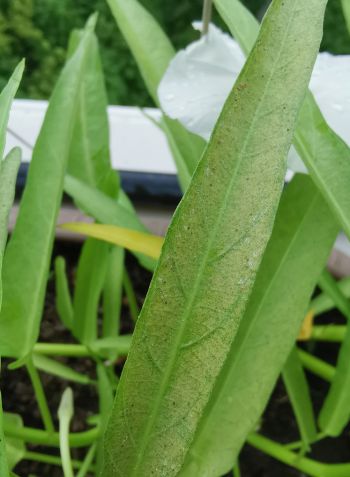 I have been growing kangkong in pots in my balcony. They get six to eight hours of sunlight and the area is fairly windy. They have been growing well and flowering. I harvested some for cooking and the plant produced new shoots just below where I had cut them. Recently, the plant showed brown patches. Is it still safe to eat? Is there a treatment for the issue?
I have been growing kangkong in pots in my balcony. They get six to eight hours of sunlight and the area is fairly windy. They have been growing well and flowering. I harvested some for cooking and the plant produced new shoots just below where I had cut them. Recently, the plant showed brown patches. Is it still safe to eat? Is there a treatment for the issue?
It appears that your kangkong plant is infested with spider mites, which are minute sap-sucking pests. They look like small, red dots on affected leaves.
These pests are attracted to plants that are under stress, such as when plants are grown in a dry and windy site.
You can help to improve the plant’s health by growing it in a more suitable location where it is more humid and less windy. A strong plant is believed to be able to ward off pest attacks better.
Spider mites can be controlled by regular applications of neem oil, summer oil or a matrine-based organic pesticide which you can purchase via online shopping platforms. Repeated applications that cover all parts of the plant are needed to keep the pest infestation low.
The plant is still safe for consumption.
Pandan serani has no scent but dyes food a vivid green
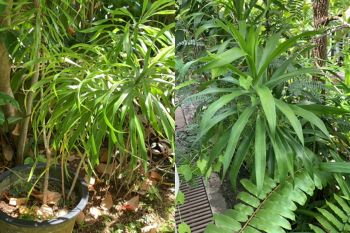 I have two plants that are supposed to be the pandan serani. I want to use the extract of the plant to obtain the natural green colouring for my pandan cakes. Which of these is the correct pandan serani?
I have two plants that are supposed to be the pandan serani. I want to use the extract of the plant to obtain the natural green colouring for my pandan cakes. Which of these is the correct pandan serani?
The two plants are different forms of Dracaena reflexa.
The one that has narrower and slightly curly leaves (left side of picture) appears to be grown as an ornamental plant locally.
I have been gifted a pandan serani plant (also known as Daun Suji) and it resembles the other form (right side of picture) that you have, which has broader and flat leaves. The leaves of the latter plant yield a vivid natural green dye that is used as a food colouring in Indonesia.
Unlike the fragrant pandan plant (Pandanus amaryllifolius) that is commonly used here for culinary purposes, the pandan serani leaves have no scent.
Flowers of moss rose last only a day
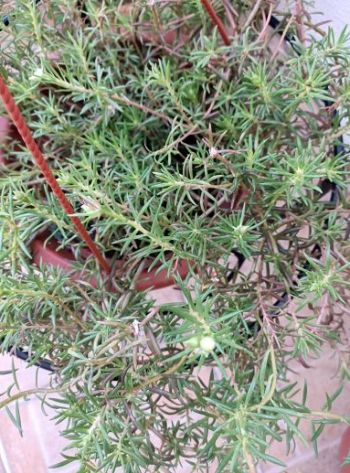 Is this the mini rose plant? I bought it during Chinese New Year and it was blooming beautifully. After about a month, it stopped blooming and never flowered again. It is growing well with more leaves and many tiny buds, but the buds never grow into full roses. The tiny roses disappear in a day or two. Why is this happening? I put the plant on the patio, which is exposed to rain and sunlight.
Is this the mini rose plant? I bought it during Chinese New Year and it was blooming beautifully. After about a month, it stopped blooming and never flowered again. It is growing well with more leaves and many tiny buds, but the buds never grow into full roses. The tiny roses disappear in a day or two. Why is this happening? I put the plant on the patio, which is exposed to rain and sunlight.
The moss rose plant needs to be grown under direct sunlight for best results. Do note that the flowers last only a day after they open. The flowers tend to wilt in the heat of the day or get damaged by heavy rain.
Check for mealy bugs, which are a common pest in this plant. They can set the plant back if left unchecked.
If you want to grow this indoors under a controlled environment, read our post on Guide to Growing Tents.
Or if you want to grow this under controlled lighting, consider using growing lights. You can read up my post on growing lights fixture where I show you the top 4 things you need to know.
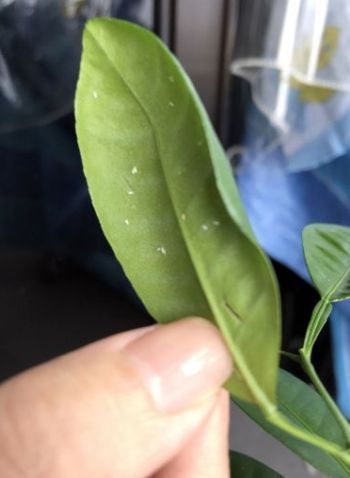 I have grown a few lime trees from seeds for about a year. They have grown well and have luxuriant leaves until about two months ago, when I started to notice numerous minute white insects around the soil, near the base of the trees and leaves. I thought they were fungus gnats, so I tried moving the trees to a spot where there is more continuous sunlight for about a week. The number of insects decreased tremendously. I moved the trees back to my balcony where there is only indirect sunlight in the afternoon. Now, the problem has returned and there are numerous white insects flying around the base of the trees and resting on the underside of the leaves. The leaves also appear to be bitten off. What should I do? Also, how long does it take for a lime tree to bear fruit?
I have grown a few lime trees from seeds for about a year. They have grown well and have luxuriant leaves until about two months ago, when I started to notice numerous minute white insects around the soil, near the base of the trees and leaves. I thought they were fungus gnats, so I tried moving the trees to a spot where there is more continuous sunlight for about a week. The number of insects decreased tremendously. I moved the trees back to my balcony where there is only indirect sunlight in the afternoon. Now, the problem has returned and there are numerous white insects flying around the base of the trees and resting on the underside of the leaves. The leaves also appear to be bitten off. What should I do? Also, how long does it take for a lime tree to bear fruit?
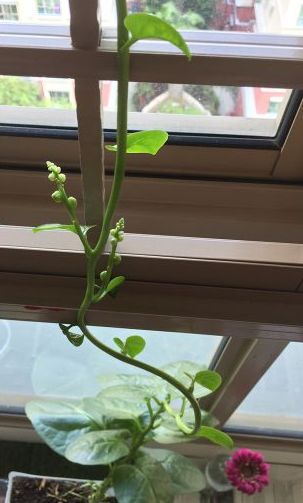 My daughter picked up the seed of this plant some time ago and grew it in a pot made from a recycled milk carton. Initially, the plant looked like a tree sapling but, lately, it grew really tall by wrapping itself around the window grilles. The leaves are round and the lowest ones are huge, bigger than my palm. The plant seems to have flowered, with the blooms quite tiny and whitish. What is this plant?
My daughter picked up the seed of this plant some time ago and grew it in a pot made from a recycled milk carton. Initially, the plant looked like a tree sapling but, lately, it grew really tall by wrapping itself around the window grilles. The leaves are round and the lowest ones are huge, bigger than my palm. The plant seems to have flowered, with the blooms quite tiny and whitish. What is this plant? 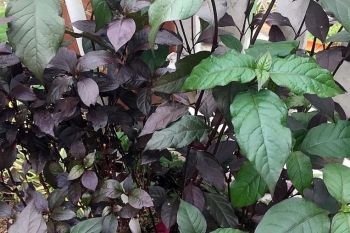 I bought a pot of ruby leaf. Its leaves were brilliant red and I thought it would look good for my fence. I transplanted it to the ground. But the leaves soon turned brown and then green. Why did this happen?
I bought a pot of ruby leaf. Its leaves were brilliant red and I thought it would look good for my fence. I transplanted it to the ground. But the leaves soon turned brown and then green. Why did this happen?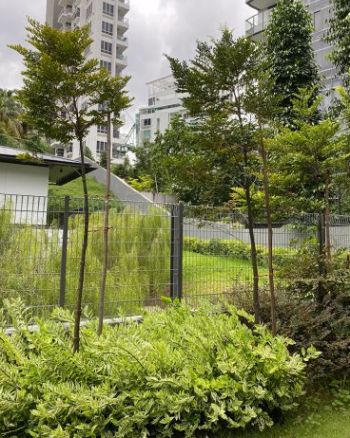 I have several Diospyros buxifolia trees in my garden. However, they seem to be sparse and the branches are not growing at the bottom. I have sprinklers attached and the trees get a good amount of water and sun. What can I do to save them?
I have several Diospyros buxifolia trees in my garden. However, they seem to be sparse and the branches are not growing at the bottom. I have sprinklers attached and the trees get a good amount of water and sun. What can I do to save them?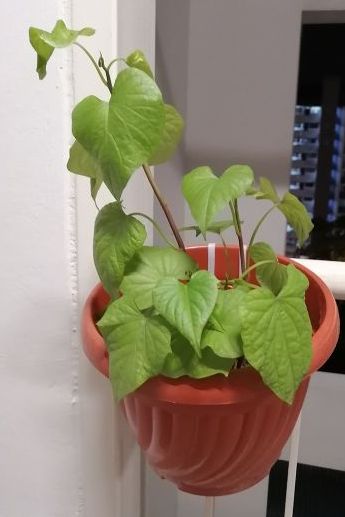 Are the leaves of my sweet potato plant edible?
Are the leaves of my sweet potato plant edible?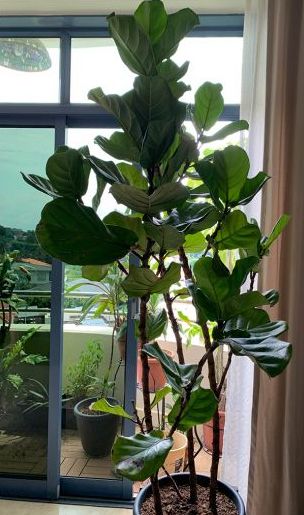 I bought this hardy-looking plant a few months ago. The florist told me it is tough and can withstand very hot sun and is good for the balcony. What plant is it?
I bought this hardy-looking plant a few months ago. The florist told me it is tough and can withstand very hot sun and is good for the balcony. What plant is it?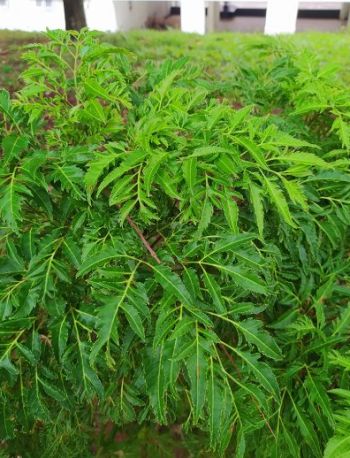 I was told that, in the Philippines, the young leaves of this shrub are used in salads. Is this true?
I was told that, in the Philippines, the young leaves of this shrub are used in salads. Is this true? 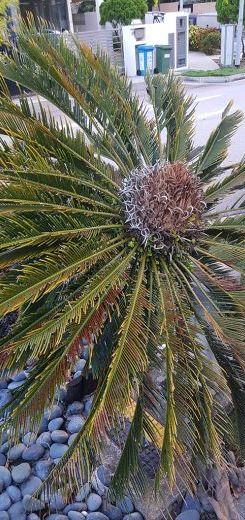 I have a palm tree which has stopped growing new leaves. I previously used a pesticide when there were new leaves growing, but they would still die. There seems to be another plant growing on the palm tree and the trunk seems to have a fungus. Is the tree still alive? What should I do?
I have a palm tree which has stopped growing new leaves. I previously used a pesticide when there were new leaves growing, but they would still die. There seems to be another plant growing on the palm tree and the trunk seems to have a fungus. Is the tree still alive? What should I do? 
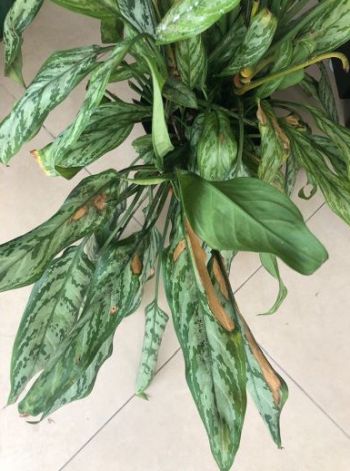 My plant, which is grown in soil, is in my balcony. It gets adequate sun, water and fertiliser regularly. Light brown spots have started appearing and, at times, white droppings are seen on the leaves, as if there is decay or disease permeating the plant. What is wrong with the plant and how can I make it healthy again?
My plant, which is grown in soil, is in my balcony. It gets adequate sun, water and fertiliser regularly. Light brown spots have started appearing and, at times, white droppings are seen on the leaves, as if there is decay or disease permeating the plant. What is wrong with the plant and how can I make it healthy again?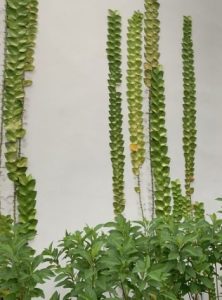 What is the name of this creeper plant?
What is the name of this creeper plant?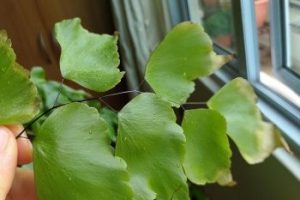 I have been nurturing this fern for nearly 10 years in my air-conditioned office. It received filtered light and I watered it every day. As I have to work from home, I took it back and placed it in a balcony where it received filtered light. My home is not air-conditioned. I am aware the plant does not like strong wind, so I move the pot from the balcony to my room if it is windy. It is well-watered and there is no sign of infestation. Of late, many leaves have been browning at the edges. The browned leaves appear fairly evenly throughout the plant, but I sense more are present on branches sheltered from light. I had observed this even when the plant was in my office, but it is more pronounced now. How can I rectify the issue?
I have been nurturing this fern for nearly 10 years in my air-conditioned office. It received filtered light and I watered it every day. As I have to work from home, I took it back and placed it in a balcony where it received filtered light. My home is not air-conditioned. I am aware the plant does not like strong wind, so I move the pot from the balcony to my room if it is windy. It is well-watered and there is no sign of infestation. Of late, many leaves have been browning at the edges. The browned leaves appear fairly evenly throughout the plant, but I sense more are present on branches sheltered from light. I had observed this even when the plant was in my office, but it is more pronounced now. How can I rectify the issue?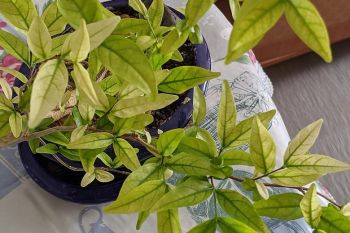 Is this plant lacking something? The leaves look unhealthy. Also, what is its name?
Is this plant lacking something? The leaves look unhealthy. Also, what is its name?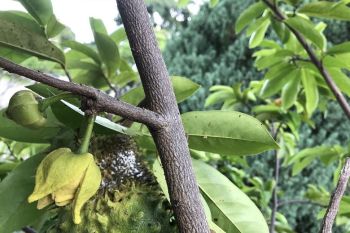 I have had this pot of cactus for more than 10 years. What is its name?
I have had this pot of cactus for more than 10 years. What is its name?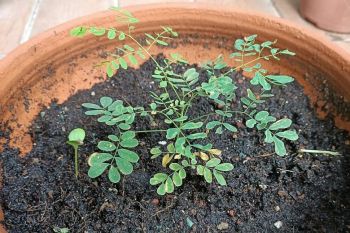 I grew a peacock flower plant from seeds. How do I care for it and will it grow to maturity and flower? Currently, some leaves are turning yellow.
I grew a peacock flower plant from seeds. How do I care for it and will it grow to maturity and flower? Currently, some leaves are turning yellow.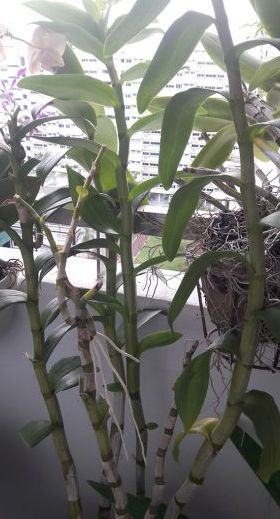 Is the new growth with roots considered a new shoot which I can cut off to re-pot? I bought the orchid plant quite a few years ago and changed its container recently. Its blooms are quite prolific.
Is the new growth with roots considered a new shoot which I can cut off to re-pot? I bought the orchid plant quite a few years ago and changed its container recently. Its blooms are quite prolific.